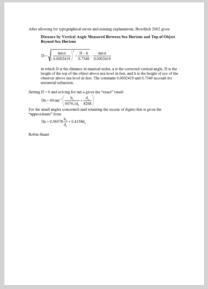
NavList:
A Community Devoted to the Preservation and Practice of Celestial Navigation and Other Methods of Traditional Wayfinding
Re: 1984 Bowditch question
From: Stan K
Date: 2016 Jul 26, 13:44 -0400
From: Stan K
Date: 2016 Jul 26, 13:44 -0400
Yes, Robin. Those are the "exact" and "approximate" formulas I was concerned with. My issue was with the statement in the current Power Squadrons Junior Navigation and Navigation courses, which only give the "approximate" formula, where it says to use the formula in Bowditch if the "approximate" formula yields a dip greater than 200' (3º20'). Apparently the "approximate" formula was in earlier editions of Bowditch, with the "exact" formula in later editions. I felt that the Power Squadrons course materials needed to be more specific as to which editions of Bowditch could be used. After I learned that the 1984 Volume I showed the "exact" formula (thanks, Frank), I found that the 1981 Volume II seemed to be the first to show it, the 1977 (and earlier) Volume I showing the "approximate" formula.
So my concern was not with how exact the "exact" formula is, though it is claimed that it is "exact" for the refraction model adopted. My concern is only to make the Power Squadrons course materials more useful.
Stan
-----Original Message-----
From: Robin Stuart <NoReply_Stuart@navlist.net>
To: slk1000 <slk1000@aol.com>
Sent: Tue, Jul 26, 2016 12:37 pm
Subject: [NavList] Re: 1984 Bowditch question
Attached File:



From: Robin Stuart <NoReply_Stuart@navlist.net>
To: slk1000 <slk1000@aol.com>
Sent: Tue, Jul 26, 2016 12:37 pm
Subject: [NavList] Re: 1984 Bowditch question
Not only do the number of decimal places in the constants not make sense but the use of an explicit arctangent function, in what Stan refers to as the “exact” formula, for typical small dip short angles is quite unnecessary and misleading in terms of overall accuracy. In the attached pdf I suggest where the arctangent may have come from.
Robin Stuart
Attached File:







